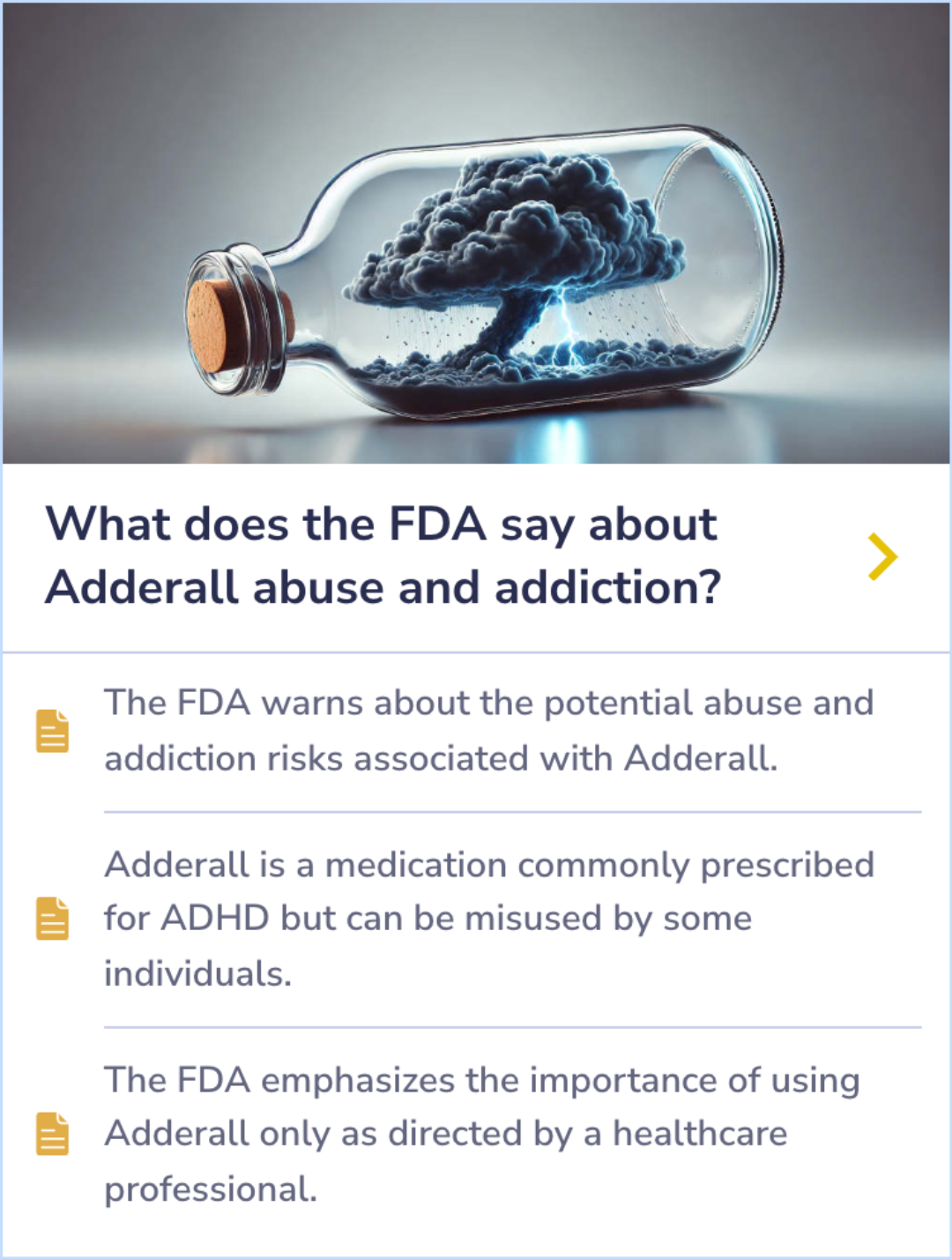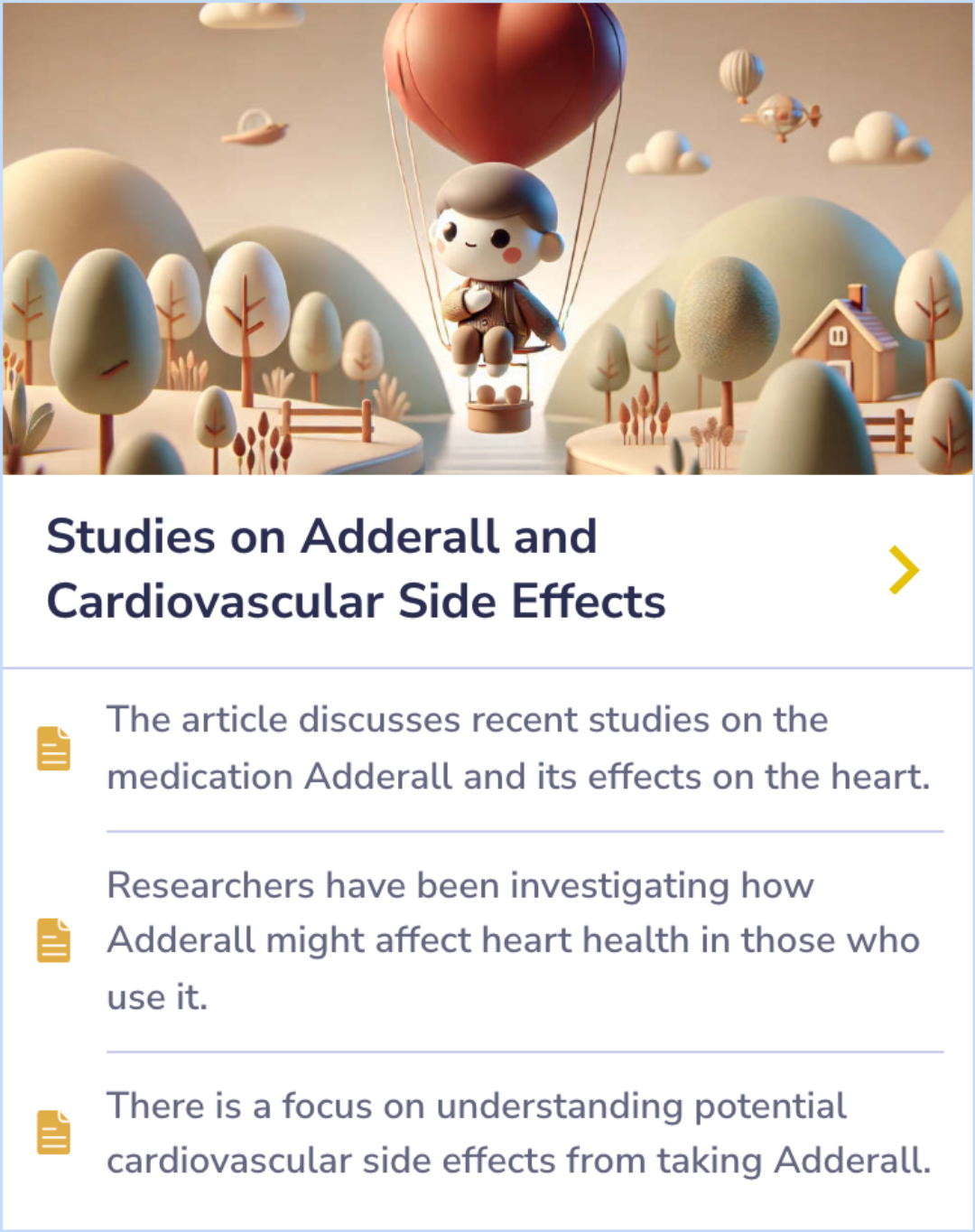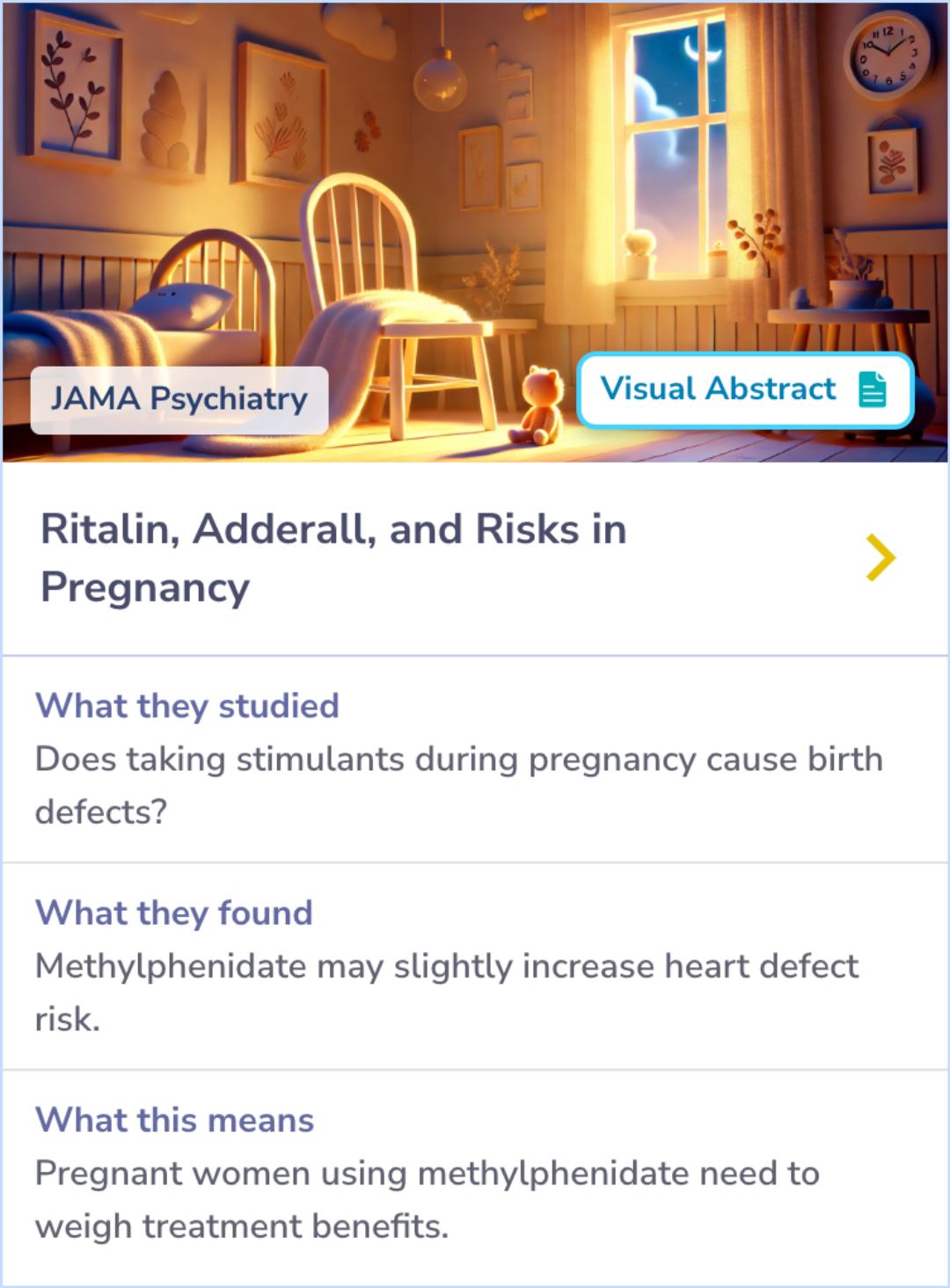Adderall
Evidence Based Answers
What does the FDA say about Adderall and Serotonin Syndrome?
The FDA highlights that using Adderall with serotonergic drugs can raise serotonin syndrome risk. They stress early symptom recognition and careful management. Combining with MAOIs is particularly dangerous and may lead to severe health issues.
Click to explore a section:
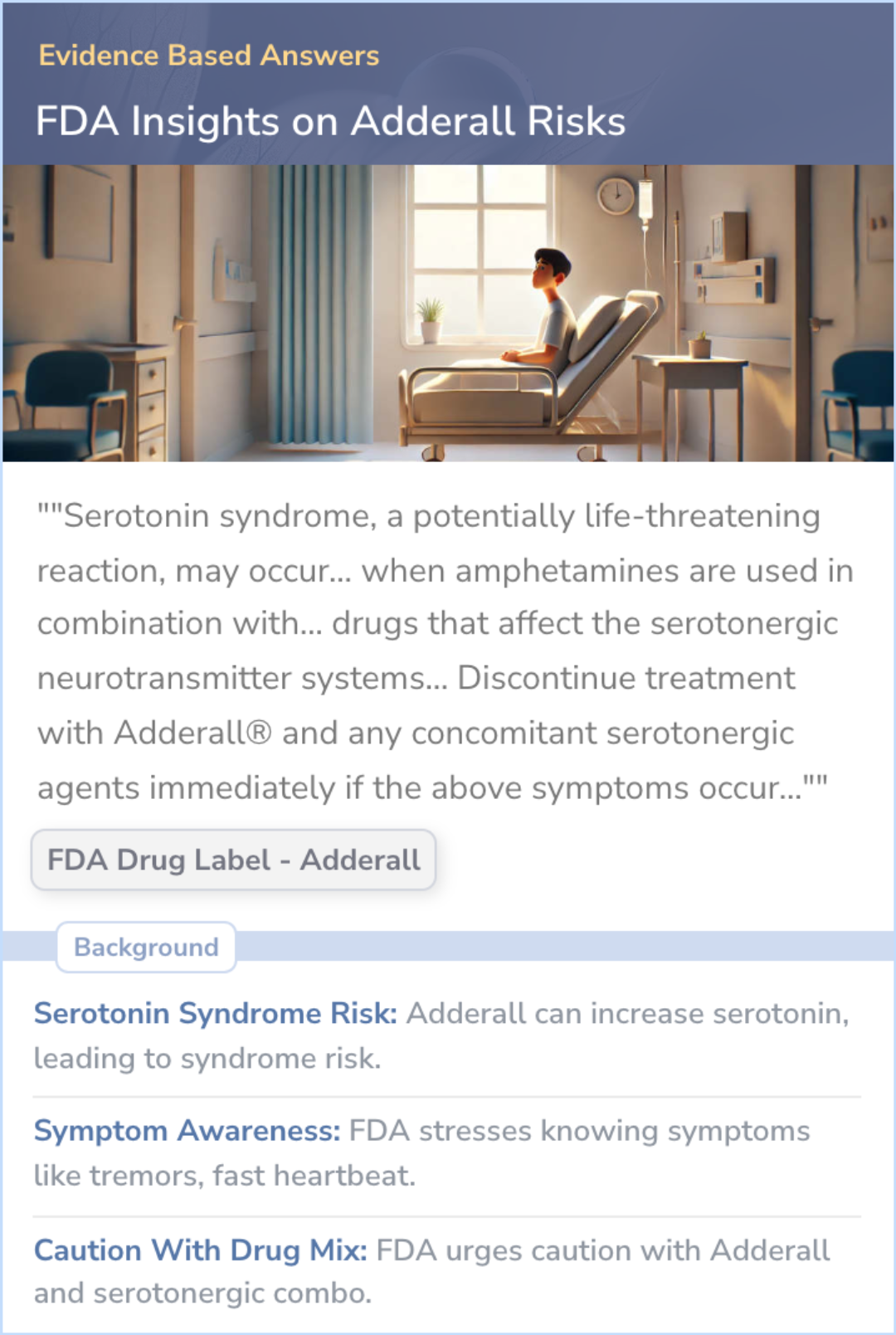
FDA notes serotonin syndrome risk with Adderall and drug combinations, emphasizes awareness of symptoms and cautious use.
FDA Drug LabelSerotonin Syndrome Risk
The FDA-approved label warns that Adderall can cause serotonin syndrome, a potentially dangerous condition, when mixed with certain drugs. These include medications affecting serotonin levels, such as some antidepressants and herbal supplements.
If combined use is necessary, it advises starting with lower doses of Adderall, monitoring for symptoms, and informing patients about the risks involved.
If combined use is necessary, it advises starting with lower doses of Adderall, monitoring for symptoms, and informing patients about the risks involved.
"Serotonin syndrome, a potentially life-threatening reaction, may occur when amphetamines are used in combination with other drugs that affect the serotonergic neurotransmitter systems such as monoamine oxidase inhibitors (MAOIs), selective serotonin reuptake inhibitors (SSRIs), serotonin norepinephrine reuptake inhibitors (SNRIs), triptans, tricyclic antidepressants, fentanyl, lithium, tramadol, tryptophan, buspirone, and St. John’s Wort [see DRUG INTERACTIONS]. Amphetamines and amphetamine derivatives are known to be metabolized, to some degree, by cytochrome P450 2D6 (CYP2D6) and display minor inhibition of CYP2D6 metabolism [see CLINICAL PHARMACOLOGY]. The potential for a pharmacokinetic interaction exists with the coadministration of CYP2D6 inhibitors which may increase the risk with increased exposure to Adderall®. In these situations, consider an alternative nonserotonergic drug or an alternative drug that does not inhibit CYP2D6 [see DRUG INTERACTIONS]. Serotonin syndrome symptoms may include mental status changes (e.g., agitation, hallucinations, delirium, and coma), autonomic instability (e.g., tachycardia, labile blood pressure, dizziness, diaphoresis, flushing, hyperthermia), neuromuscular symptoms (e.g., tremor, rigidity, myoclonus, hyperreflexia, incoordination), seizures, and/or gastrointestinal symptoms (e.g., nausea, vomiting, diarrhea). Discontinue treatment with Adderall® and any concomitant serotonergic agents immediately if the above symptoms occur, and initiate supportive symptomatic treatment. If concomitant use of Adderall® with other serotonergic drugs or CYP2D6 inhibitors is clinically warranted, initiate Adderall® with lower doses, monitor patients for the emergence of serotonin syndrome during drug initiation or titration, and inform patients of the increased risk for serotonin syndrome. "
Source:FDA Drug Label - AdderallUnderstanding Serotonin Syndrome and Adderall
Serotonin syndrome is a condition that can occur when there is too much serotonin in the brain. This may happen when Adderall, a stimulant, interacts with drugs that also affect serotonin levels. Symptoms can include mental changes such as agitation and hallucinations, as well as physical issues like tremors, high blood pressure, and nausea.
The FDA notes that combining Adderall with serotonergic drugs requires careful management to reduce the risk of serotonin syndrome.
The FDA notes that combining Adderall with serotonergic drugs requires careful management to reduce the risk of serotonin syndrome.
“
Source Quotes:
Serotonin syndrome, a potentially life-threatening reaction, may occur when amphetamines are used in combination with other drugs that affect the serotonergic neurotransmitter systems such as monoamine oxidase inhibitors (MAOIs), selective serotonin reuptake inhibitors (SSRIs), serotonin norepinephrine reuptake inhibitors (SNRIs), triptans, tricyclic antidepressants, fentanyl, lithium, tramadol, tryptophan, buspirone, and St. John's Wort.
The combination of a serotonergic medication with a stimulant can lead to excessive serotonin activity.
Recognizing Symptoms of Serotonin Syndrome with Adderall
Symptoms of serotonin syndrome can include confusion, hallucinations, tremors, a fast heartbeat, and a high body temperature. Nausea and vomiting are also common. Recognizing these symptoms early can help prevent severe outcomes.
The FDA emphasizes awareness of these symptoms when prescribing Adderall alongside serotonergic drugs.
The FDA emphasizes awareness of these symptoms when prescribing Adderall alongside serotonergic drugs.
“
Source Quotes:
Serotonin syndrome symptoms may include mental status changes (e.g., agitation, hallucinations, delirium, and coma), autonomic instability (e.g., tachycardia, labile blood pressure, dizziness, diaphoresis, flushing, hyperthermia), neuromuscular symptoms (e.g., tremor, rigidity, myoclonus, hyperreflexia, incoordination), seizures, and/or gastrointestinal symptoms (e.g., nausea, vomiting, diarrhea).
We monitor individuals treated with the combination of serotonergic reuptake inhibitor and stimulant for the presence of serotonin syndrome, a potentially life-threatening syndrome caused by excessive serotonin activity.
Using Adderall with Serotonergic Drugs
The FDA advises caution when using Adderall with serotonergic drugs or CYP2D6 inhibitors, as this may increase the risk of serotonin syndrome. Lower starting doses and careful monitoring are recommended, especially for patients taking antidepressants or other serotonergic medications.
“
Source Quotes:
If concomitant use of Adderall® with other serotonergic drugs or CYP2D6 inhibitors is clinically warranted, initiate Adderall® with lower doses, monitor patients for the emergence of serotonin syndrome during drug initiation or titration, and inform patients of the increased risk for serotonin syndrome.
The use of amphetamine with other serotonergic agents and/or CYP2D6 inhibitors (including fluoxetine, paroxetine, and bupropion) can increase the risk of serotonin syndrome. Amphetamine should be started cautiously in patients taking these medications, with close monitoring for signs and symptoms of serotonin syndrome.
Adderall and Monoamine Oxidase Inhibitors: Serious Risks
Combining Adderall with monoamine oxidase inhibitors (MAOIs) poses significant risks, including potentially severe reactions such as hypertensive crises that may lead to strokes or heart attacks. This combination can be fatal, and use of Adderall should be avoided in patients taking MAOIs.
Patients must inform their doctors of any MAOI use to prevent dangerous interactions.
Patients must inform their doctors of any MAOI use to prevent dangerous interactions.
“
Source Quotes:
Concomitant use of MAOIs and CNS stimulants can cause hypertensive crisis. Potential outcomes include death, stroke, myocardial infarction, aortic dissection, ophthalmological complications, eclampsia, pulmonary edema, and renal failure.
Key Takeaways
Conclusions
Serotonin syndrome is a serious condition that can arise when Adderall interacts with drugs affecting serotonin levels. The FDA highlights that this condition can cause mental and physical symptoms such as agitation, hallucinations, and tremors. Caution is advised when using Adderall with serotonergic medications, including antidepressants, to minimize risks.
Additionally, combining Adderall with monoamine oxidase inhibitors (MAOIs) can result in dangerous outcomes, including life-threatening events like strokes or heart attacks. The FDA recommends avoiding such combinations and ensuring careful monitoring when prescribed alongside serotonergic drugs.
Additionally, combining Adderall with monoamine oxidase inhibitors (MAOIs) can result in dangerous outcomes, including life-threatening events like strokes or heart attacks. The FDA recommends avoiding such combinations and ensuring careful monitoring when prescribed alongside serotonergic drugs.
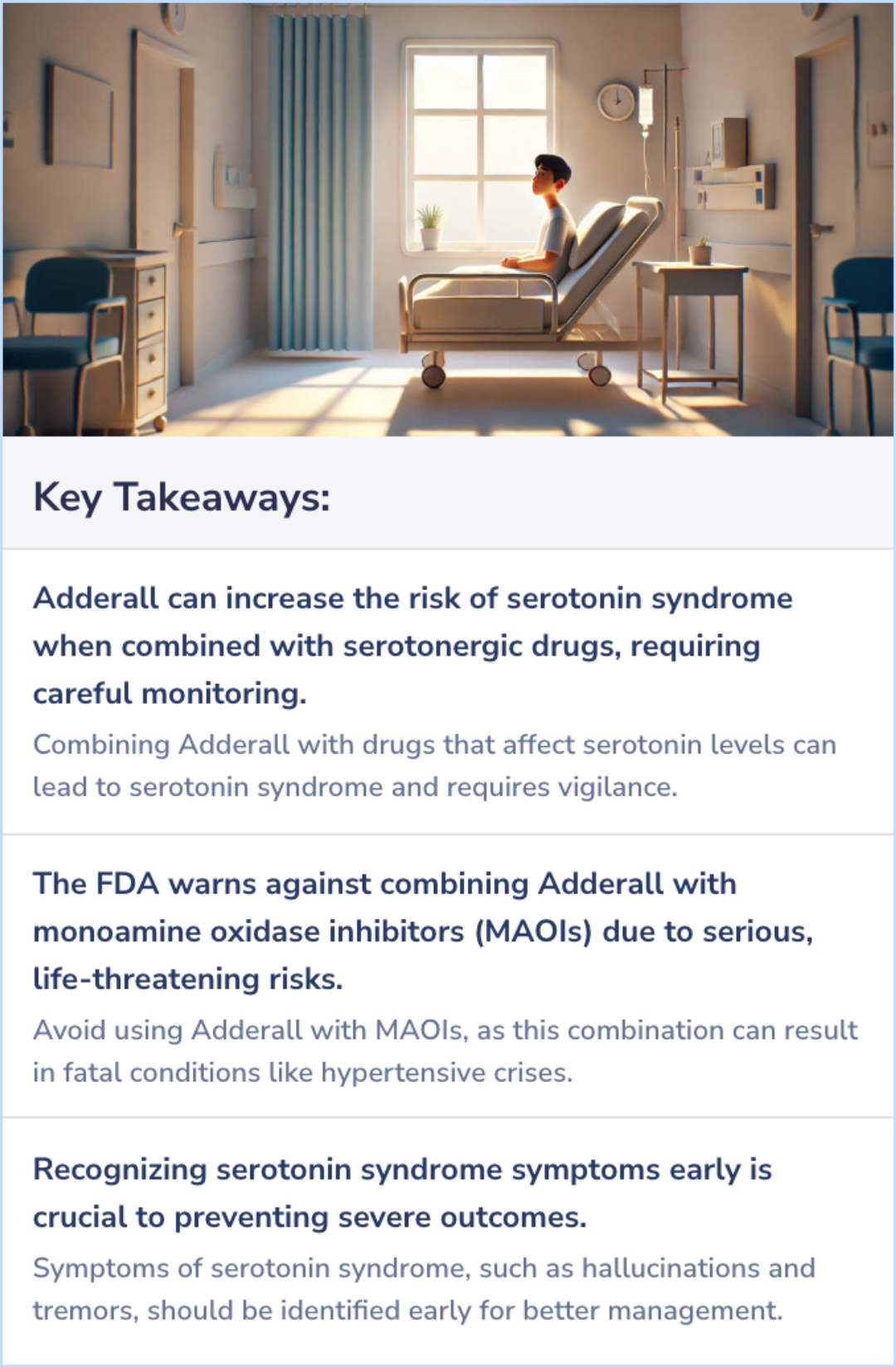
Evidence Summary
FDA Warnings on Adderall Misuse and Addiction Risks
The FDA cautions against Adderall misuse due to its addiction potential, underscoring the importance of taking it only with medical supervision. Adderall is primarily used to treat ADHD, but it carries risks when not used as prescribed.
Healthcare professionals play a key role in minimizing misuse and ensuring Adderall's safe administration by closely monitoring usage and adherence to prescribed regimens.
Healthcare professionals play a key role in minimizing misuse and ensuring Adderall's safe administration by closely monitoring usage and adherence to prescribed regimens.
Evidence Summary
How Adderall May Impact Heart Health
Research on Adderall raises concerns about how the medication may influence heart health, specifically the potential for cardiovascular side effects. Researchers are looking closely at how these effects might present in individuals who regularly take Adderall.
Several studies investigate whether using Adderall could impact aspects of heart function, with attention to those who might experience increased risks.
The focus is on possible side effects like irregular heart rhythms and other cardiovascular responses in those on this medication.
Several studies investigate whether using Adderall could impact aspects of heart function, with attention to those who might experience increased risks.
The focus is on possible side effects like irregular heart rhythms and other cardiovascular responses in those on this medication.
Evidence Summary
Stimulant Use During Pregnancy and Birth Defect Risks
Stimulant use during pregnancy is becoming more common, raising questions about its effects on fetal development. This study explores whether methylphenidate and amphetamines, taken early in pregnancy, are linked to birth defects.
The findings show a slight increase in heart defect risks for infants exposed to methylphenidate but not amphetamines. For major malformations overall, amphetamines show no additional risk, while methylphenidate suggests only a minimal increase.
These results provide a clearer picture of the risks associated with these medications during early pregnancy.
The findings show a slight increase in heart defect risks for infants exposed to methylphenidate but not amphetamines. For major malformations overall, amphetamines show no additional risk, while methylphenidate suggests only a minimal increase.
These results provide a clearer picture of the risks associated with these medications during early pregnancy.
